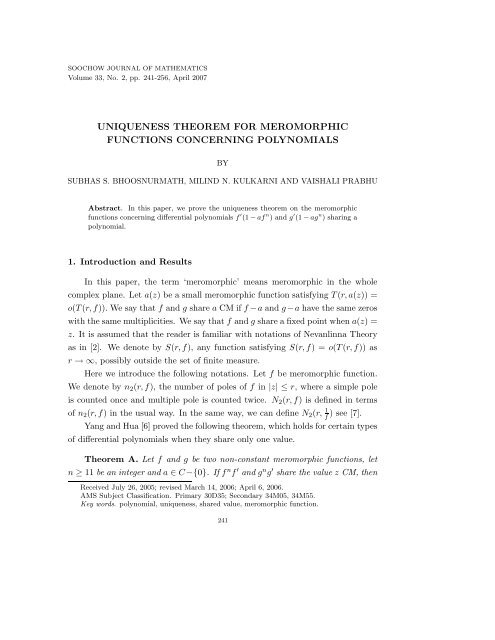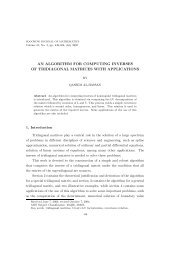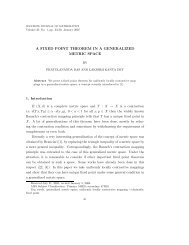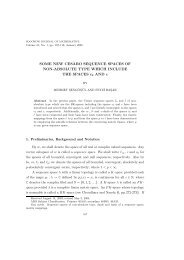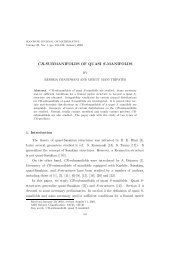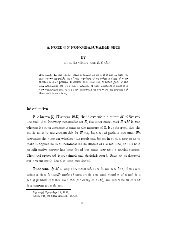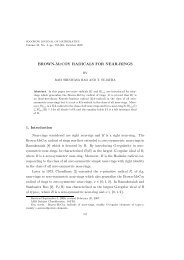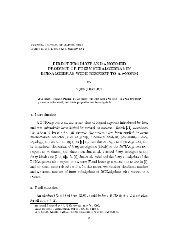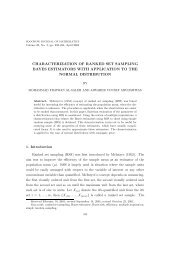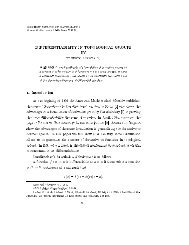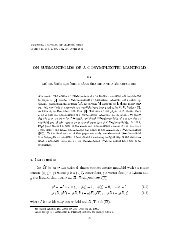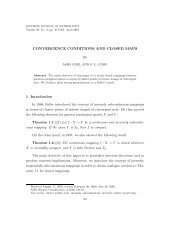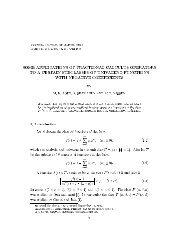uniqueness theorem for meromorphic functions concerning ...
uniqueness theorem for meromorphic functions concerning ...
uniqueness theorem for meromorphic functions concerning ...
You also want an ePaper? Increase the reach of your titles
YUMPU automatically turns print PDFs into web optimized ePapers that Google loves.
SOOCHOW JOURNAL OF MATHEMATICSVolume 33, No. 2, pp. 241-256, April 2007UNIQUENESS THEOREM FOR MEROMORPHICFUNCTIONS CONCERNING POLYNOMIALSBYSUBHAS S. BHOOSNURMATH, MILIND N. KULKARNI AND VAISHALI PRABHUAbstract. In this paper, we prove the <strong>uniqueness</strong> <strong>theorem</strong> on the <strong>meromorphic</strong><strong>functions</strong> <strong>concerning</strong> differential polynomials f ′ (1 − af n ) and g ′ (1 − ag n ) sharing apolynomial.1. Introduction and ResultsIn this paper, the term ‘<strong>meromorphic</strong>’ means <strong>meromorphic</strong> in the wholecomplex plane. Let a(z) be a small <strong>meromorphic</strong> function satisfying T(r,a(z)) =o(T(r,f)). We say that f and g share a CM if f −a and g −a have the same zeroswith the same multiplicities. We say that f and g share a fixed point when a(z) =z. It is assumed that the reader is familiar with notations of Nevanlinna Theoryas in [2]. We denote by S(r,f), any function satisfying S(r,f) = o(T(r,f)) asr → ∞, possibly outside the set of finite measure.Here we introduce the following notations. Let f be <strong>meromorphic</strong> function.We denote by n 2 (r,f), the number of poles of f in |z| ≤ r, where a simple poleis counted once and multiple pole is counted twice. N 2 (r,f) is defined in termsof n 2 (r,f) in the usual way. In the same way, we can define N 2 (r, 1 f) see [7].Yang and Hua [6] proved the following <strong>theorem</strong>, which holds <strong>for</strong> certain typesof differential polynomials when they share only one value.Theorem A. Let f and g be two non-constant <strong>meromorphic</strong> <strong>functions</strong>, letn ≥ 11 be an integer and a ∈ C−{0}. If f n f ′ and g n g ′ share the value z CM, thenReceived July 26, 2005; revised March 14, 2006; April 6, 2006.AMS Subject Classification. Primary 30D35; Secondary 34M05, 34M55.Key words. polynomial, <strong>uniqueness</strong>, shared value, <strong>meromorphic</strong> function.241
MEROMORPHIC FUNCTIONS CONCERNING POLYNOMIALS 243orT(r,f) ≤ N(r,f) + (k + 1)N(r, 1 ) (+ N r,f1) (f (k) − N 0 r,− c1)f (k+1) + S(r,f),where N 0 (r,1f (k+1) ) is the counting function which counts only those zeros of f (k+1)which are not the zeros of f.Lemma 2.([2], [7]) Let f be a <strong>meromorphic</strong> function. If there exists two<strong>functions</strong> a i (z) such thatT(r,a i ) = S(r,f), i = 1,2,then(T(r,f) ≤ N(r,f) + N r,1) (+ N r,f − a 11)+ S(r,f).f − a 2we haveLemma 3.([4]) Let f be a <strong>meromorphic</strong> function, <strong>for</strong> any integer n, a ≠ 0,nT(r,f) < N(r,f) + N(r, 1 ) ( )1+ N r,f f ′ (1 − af n + S(r,f).)Lemma 4.([5]) If f be a <strong>meromorphic</strong> function and if P(z) = a n z n +a n−1 z n−1 + · · · + a 0 where a n (≠ 0), a n ,a n−1 ,... ,a 0 are constants, thenT(r,P(f)) = nT(r,f) + S(r,f).Lemma 5. Let f and g be two non-constant <strong>meromorphic</strong> <strong>functions</strong> and kbe a positive integer. If f (k) and g (k) share 1 CM andthen, f (k) g (k) ≡ 1 or f ≡ g.Proof. Let,Θ(0,f) + Θ(0,g) + Θ(∞,f) + Θ(∞,g) > 4k + 7k + 2 ,Φ(z) = f(k+2) (z)f (k+1) (z) − 2f(k+1) (z)f (k)−1 (z) − g(k+2) (z)g (k+1) (z) + 2g(k+1) (z)g (k)−1 (z) . (1)If z 0 is a simple 1-point of f (k) and g (k) , substituting their Taylor’s series at z 0in (1), we see that z 0 is a zero of Φ(z). Thus, we have1) (1)N 1)(r,f (k) = N 1) r,− 1 g (k) − 1
246 SUBHAS S. BHOOSNURMATH, MILIND N. KULKARNI AND VAISHALI PRABHUThus, put c = 1 + 1 b, we deduce from Lemma 1, that(T(r,f) ≤ N(r,f) + (k + 1)N r, 1 )+ S(r,f),fT(r,f) ≤ (k + 1) {2 − [Θ(0,f) + Θ(∞,f)]} T(r,f) + S(r,f)≤ (k+1) {4−[Θ(0,f)+Θ(0,g)+Θ(∞,g)+Θ(∞,f)]} T(r,f)+S(r,f),and hence{[Θ(0,f) + Θ(0,g) + Θ(∞,g) + Θ(∞,f)] − 4k + 3 }T(r,f) ≤ S(r,f), (9)k + 1which is a contradiction as we have by our hypothesis that[Θ(0,f) + Θ(0,g) + Θ(∞,g) + Θ(∞,f)] ≥ 4k + 7k + 3 .There<strong>for</strong>e if a = b and b ≠ 0, then b ≠ −1 is the only possibility.Case 2. b ≠ 0 and a ≠ b.From (8), we seeg (k) − 1b(f (k) − 1) = g(k) + a − b ≠ 0.bFrom Lemma 1, we deduce that(T(r,g) ≤ N(r,g) + (k + 1)N r, 1 )+ S(r,g),gT(r,g) ≤ (k + 1) {2 − [Θ(0,g) + Θ(∞,g)]}T(r,g) + S(r,g)≤ (k + 1) {4 − [Θ(0,f) + Θ(0,g) + Θ(∞,g) + Θ(∞,f)]}T(r,g) + S(r,g),and hence{[Θ(0,f) + Θ(0,g) + Θ(∞,g) + Θ(∞,f)] − 4k + 3 }T(r,g) ≤ S(r,g), (10)k + 1which is a contradiction to our hypothesis.Case 3. a ≠ 0 and b = 0. From (8), we get1f (k) − 1 = ag (k) − 1 ,f (k) = 1 a g(k) + a − 1a ,
MEROMORPHIC FUNCTIONS CONCERNING POLYNOMIALS 247where P(z) is a polynomial in z.f = 1 g + P(z), (11)aIf P(z) ≠ 0, then by Lemma 2 we have(T(r,f) ≤ N(r,f) + N r, 1 ) ( )1+ N r, + S(r,f)f f − P(z)(= N(r,f) + N r, 1 ) (+ N r, 1 )+ S(r,f)f g≤ [2 − (Θ(0,f) + Θ(∞,f))] T(r,f) + [1 − Θ(0,g)] T(r,g) + S(r,g).But by (9), we have T(r,f) = T(r,g) + S(r,f).Hence, we get{[Θ(0,f) + Θ(∞,f) + Θ(0,g)] − 2} T(r,f) ≤ S(r,f).But by hypothesis, ∆ > 4k+7k+2hence P(z) = 0. This impliesimplies T(r,f) < S(r,f) which is a contradiction,f = 1 a g.Now, if a ≠ 1 and since f (k) and g (k) share 1 CM, we get g (k) ≠ 1 which is acontradiction. There<strong>for</strong>e a = 1 and hence f = g.Hence this proves the Lemma.Lemma 6.([8]) Let F and G be two <strong>meromorphic</strong> <strong>functions</strong> such that F andG share 1 CM, and letIf H ≠ 0, thenH =( F′′F ′ − 2 F ′ ) ( ) G′′−F − 1 G ′ − 2 G′.G − 1T(r) < N 2 (r,F) + N 2 (r, 1 F ) + N 2(r,G) + N 2 (r, 1 G ) + S(r),whereT(r) = max {T(r,F),T(r,G)} ,S(r) = o(T(r)),(r → ∞,r /∈ E),E is the set of finite linear measure.
248 SUBHAS S. BHOOSNURMATH, MILIND N. KULKARNI AND VAISHALI PRABHULemma 7.([8]) If H ≡ 0, andN(r, 1 Flim) + N(r, 1 G) + N(r,F) + N(r,G)r→∞T(r,F)< 1,r ∈ I where I is the set with infinite linear measure then, FG ≡ 1 or F ≡ G.Lemma 8.([4]) If f is non constant <strong>meromorphic</strong> function, thennT(r,f) < ¯N(r,f)(+ T r, 1 )+f¯N(1)r,f ′ (1 − af n + S(r,f).)Lemma 9. Let f and g be two non constant <strong>meromorphic</strong> <strong>functions</strong>, n ≥ 7,be a positive integer, α(z) be a small <strong>meromorphic</strong> function such that T(r,α(z)) =o(T(r,f)) and α ≠ 0, ∞ and letF = f ′ (1 − af n ), G = g ′ (1 − ag n ),where a is (n −1) th root of unity. If F, G share α(z) CM, then S(r,f) = S(r,g).Proof. By Lemma 4, we have(nT(r,f) = T r, f ′ (1 − af n ))f ′ + O(1)≤ T(r,F) + T(r,f ′ ) + O(1),nT(r,f) ≤ T(r,F) + 2T(r,f) + O(1),(n − 2)T(r,f) ≤ T(r,F) + O(1), (12)and by Second Fundamental Theorem, and using the hypothesis that F and Gshare α(z) CM, we haveorAsN(r,T(r,F) ≤ N(r,F) + N(T(r,F) ≤ N(r,f)+N r,1) (1 − af n ≤ N r,(r, 1 ) (1)+ N r, + S(r,f),F F − α1) (1 − af n ≤ T r,1)1 − af n +N(r, 1 ) (f ′ +N r,T(r,F) ≤ T(r,f) + T(r,f) + T(r,f ′ ) + N1)≤ T(r,f) + O(1),af(r,1)+S(r,f).G − α1)+ S(r,f),G − α
MEROMORPHIC FUNCTIONS CONCERNING POLYNOMIALS 249or(1)T(r,F) ≤ 4T(r,f) + N r, + S(r,f).G − αThere<strong>for</strong>eT(r,F) ≤ 4T(r,f) + T(r,G) + S(r,f). (13)As in [3] we note thatBy using (12) and (13), we getororT(r,G) = T(r,g ′ (1 − ag n ))≤ (n + 2)T(r,g) + S(r,g).(n − 2)T(r,f) ≤ T(r,F) + O(1) ≤ 4T(r,f) + T(r,G) + S(r,f),(n − 6)T(r,f) ≤ T(r,G) + S(r,f),(n − 6)T(r,f) ≤ (n + 2)T(r,g) + S(r,g) + S(r,f),and hence S(r,f) ≤ S(r,g), <strong>for</strong> n ≥ 7.Similarly,and henceThere<strong>for</strong>e(n − 6)T(r,g) ≤ (n + 2)T(r,f) + S(r,f) + S(r,g),S(r,g) ≤ S(r,f), <strong>for</strong> n ≥ 7.S(r,g) = S(r,f).This proves the lemma.Proof. By Lemma 9, we have, S(r,f) = S(r,g).Let F = f ′ (1 − af n )P(z), G = g′ (1 − ag n ), (14)P(z)andF ∗ = f − afn+1n + 1 ,As, F and G share 1 CM, by Lemma 4,G∗ = g − agn+1n + 1 . (15)T(r,F ∗ ) = (n + 1)T(r,f) + S(r,f), (16)
MEROMORPHIC FUNCTIONS CONCERNING POLYNOMIALS 251There<strong>for</strong>e (19) becomesT(r,F ∗ ) ≤ T(r,F) + 2T(r,f) + O(log r) + S(r,f). (20)Let H be defined as in Lemma 6 and let H ≠ 0.Then by using Lemma 6 and equation (14), we obtain that(N 2 (r,F) + N 2 r, 1 )(1)≤ 2N(r,f) + N r,F1 − af n + N(r, 1 )f ′ + O(log r), (21)(N 2 (r,G) + N 2 r, 1 )(≤ 2N(r,g) + N r,GNow using (14)-(22) in (20) we have1)1 − ag n + N(r, 1 g ′ )+ O(log r). (22)(T(r,F ∗ ) ≤ N 2 (r,F) + N 2 r, 1 ) (+ N 2 (r,G) + N 2 r, 1 )+ 2T(r,f) + O(log r)FG+S(r,f)≤ 2N(r,f) + N(r,1)(1 − af n + 2N(r,g) + N r,+N(r, 1 )f ′ + 2T(r,f) + O(log r),1)1 − ag n + N(r, 1 )g ′and N(r, 1 g ′ ) ≤ T(r, 1 g ′ ) = T(r,g ′ ) + o(1) = 2T(r,g) + S(r,g). There<strong>for</strong>eN(r, 1 g ′) ≤ 2T(r,g) + S(r,g), (23)(T(r,F ∗ 1) (1)) ≤ 2N(r,f) + 2N(r,g) + N r,1 − ag n + N r,1 − af n + 2T(r,g)+2T(r,f) + 2T(r,f) + O(log r) + S(r,f). (24)By (16), we have((n + 1)T(r,f) ≤ 2N(r,f) + 2N(r,g) + N r,Similarly, we can prove1)1 − ag n+2T(r,g) + 2T(r,f) + 2T(r,f),(+ N r,1)1 − af n=⇒ (n − 6)T(r,f) ≤ 5T(r,g) + O(log r) + S(r,f). (25)(n − 6)T(r,g) ≤ 5T(r,f) + O(log r) + S(r,f), (26)
252 SUBHAS S. BHOOSNURMATH, MILIND N. KULKARNI AND VAISHALI PRABHUas we get n ≠ 11 which is a contradiction to our hypothesis. There<strong>for</strong>e,orIntegrating, we get1F − 1 =where A ≠ 0, B are constants. Thus,We have(N r, 1 )F≤ N(+ N(r, 1 g ′ )+ NH ≡ 0.F ′′F ′ − 2 f ′F − 1 = G′′G ′ − 2 G′G − 1 . (27)AG − 1 + B,T(r,F) = T(r,G) + S(r,f). (28)r, 1 )+ N(r,F) + N(r,G)G(r, 1 )f ′ + N(r,f) + N(r,g) + N≤ 4T(r,f) + N(r, 1 )g ′ + N(r, 1 )f ′ + O(log r) + S(r,f).Note thatN(r, 1 )f ′(r, 1 ) (+ N r, 1 )+ O(log r)f g≤ T(r,f ′ ) − m(r, 1 )f ′ ≤ 2T(r,f) − m(r, 1 )f ′ + S(r,f),andT(r,F) + m(r, 1 ) (f ′ = T r, f ′ (1 − af n )zT(r,F) + m(r, 1 ) (f ′ ≥ T r,f ′ (1 − af n ))+ m(r, 1 )f ′ ,)− O(log r). (29)There<strong>for</strong>e{N(r,1Flim supr→∞ T(r,F) + N(r, 1 G )}T(r,F) + N(r,F)T(r,F) + N(r,G) ≤ 1,T(r,F)as n ≥ 7.There<strong>for</strong>e by Lemma 7 either F ≡ G or FG ≡ 1.We shall now show that FG ≡ 1, is not possible.Suppose FG ≡ 1, is possible thenf ′ (1 − af n )g ′ (1 − ag n ) ≡ P(z) 2 , (30)
MEROMORPHIC FUNCTIONS CONCERNING POLYNOMIALS 253f ′ (1 − af n ) ≠ 0, g ′ (1 − ag n ) ≠ 0,or if z 0 is a zero of f ′ (1 − af n ) of order m then it is a pole of g ′ (1 − ag n ) of orderm. So,N( )1r,f ′ (1 − af n = N ( r,g ′ (1 − ag n ) ) = N(r,g),)provided z 0 is not a zero of P(z). Now by using Lemma 3, we get that(nT(r,f) < N(r,f) + N r, 1 )+ N(r,g) + S(r,f),fnT(r,f) ≤ 2−{Θ(0,f)+Θ(∞,f)} T(r,f) + [1−Θ(∞,g)] T(r,g)+S(r,f). (31)But(T(r,f ′ (1 − af n P(z) 2 ))) = T r,g ′ (1 − ag n )(= T(r,P(z) 2 ) + T r,(≤ O(log r) + T r,1g ′ (1 − ag n )1g ′ (1 − ag n ))+ log 2)+ log 2≤ T(r,g ′ ) + T(r,(1 − ag n )) + S(r,g),and alsoT(r,f ′ (1 − af n ) ≤ (n + 2)T(r,g) + S(r,g), (32)nT(r,f) = T(r, afn )(≤ T(r,af n ) + S(r,f) = T r, f ′ (1 − af n ))af ′ + c≤ T(r,f ′ ) + T(r,f ′ (1 − af n )) + S(r,f),(n − 2)T(r,f) ≤ T(r,f ′ (1 − af n )) + S(r,f). (33)Using (31), we getSimilarly, we can prove(n − 2)T(r,f) ≤ (n + 2)T(r,g) + S(r,g) + S(r,f).(n − 2)T(r,g) ≤ (n + 2)T(r,f) + S(r,g) + S(r,f).Hence S(r,g) = S(r,f). Now, we claim thatT(r,g) ≤ T(r,f) + S(r,f).
254 SUBHAS S. BHOOSNURMATH, MILIND N. KULKARNI AND VAISHALI PRABHUSuppose, if possibleT(r,f) < T(r,g),then, by (32), we get,T(r,g) ≤ n + 2 T(r,f) + S(r,f),n − 2T(r,g) ≤ T(r,f) + S(r,f),which is a contradiction, henceT(r,g) ≤ T(r,f).Now, using (30) we get,nT(r,f) ≤ 4 − [Θ(∞,f) + Θ(0,g) + Θ(0,f) + Θ(∞,g)] T(r,f) + S(r,f),which gives(n − 4 + ∆)T(r,f) ≤ S(r,f),where ∆ = Θ(∞,f) + Θ(0,g) + Θ(0,f) + Θ(∞,g). Since n ≥ 7, k ≥ 1. There<strong>for</strong>eT(r,f) ≥ S(r,f),which is a contradiction. HenceFG ≡ 1,is not possible.Hence, F ≡ G. We have,(F ∗ ) ′ = FP(z),and henceSimilarly,As F ≡ GF = (F ∗ ) ′P(z) .G = (G∗ ) ′P(z) .(F ∗ ) ′ = (G ∗ ) ′ ,
MEROMORPHIC FUNCTIONS CONCERNING POLYNOMIALS 255and henceF ∗ = G ∗ + c,where c is a constant. And henceT(r,f) = T(r,g) + S(r,f). (34)Suppose c ≠ 0, by Second Fundamental Theorem(T(r,G ∗ 1) (1)) = (n + 1)T(r,g) < N r,G ∗ + N r,G ∗ + N(r,G ∗ ) + S(r,g)(+ C≤ N r, 1 ) ( )1(+N r,g g n +N(r,g)+N r, 1 ) ( )1+N r,−af f n +S(r,f)− a≤ 5T(r,f) + S(r,f),which is a contradiction to (25), there<strong>for</strong>e c = 0, and hencef n+1 { 1f n −F ∗ = G ∗ ,f − afn+1n + 1 = g − agn+1n + 1 ,a }n + 1= g n+1 { 1g n −a }.n + 1Now, leth = f g .If h = 1, then f ≡ g.Suppose h ≠ 1, thenh n+1 { 1f n −h n+1 { 1g n h n −a }n + 1a }n + 1= 1g n −= 1g n −hg n − ahn+1n + 1 = 1g n −1(h − 1) =agn n + 1an + 1 ,an + 1 ,an + 1 ,{h n+1 − 1 } ,=⇒ g n = n + 1a{ } h − 1h n+1 − 1and f n = h nn + 1a{ } h − 1h n+1 ,− 1
256 SUBHAS S. BHOOSNURMATH, MILIND N. KULKARNI AND VAISHALI PRABHU[ n + 1=⇒ g =a( )] 1h − 1 nh n+1 − 1and f =[h nn + 1 ( )] 1h − 1 n.a h n+1 − 1Acknowledgments1. The second author thanks the University Grants Comission (India) <strong>for</strong> theaward of Teacher Fellowship under Faculty Improvement Programme.2. The authors thank the refrees <strong>for</strong> going through the paper carefully andmaking valuable suggestions towards the improvement of the paper.References[1] M. L. Fang and Hong Wei, A unicity <strong>theorem</strong> <strong>for</strong> entire function <strong>concerning</strong> differentialpolynomials, Indian Journal of Pure and Applied Mathematics, 32:9(2001), 1343-1348.[2] W. K. Hayman, Meromorphic Functions, Claredon Press, Ox<strong>for</strong>d, 1964.[3] Weichuan Lin and Hong Xun Yi, Uniqueness <strong>theorem</strong> <strong>for</strong> <strong>meromorphic</strong> <strong>functions</strong> <strong>concerning</strong>fix points, Complex Variable Theory Appl., 49:11(2004), 793-806.[4] A. G. Puranik, Picard exceptional values, fix-points and related topics <strong>concerning</strong> differentialpolynomials, Ph.D thesis, Karnatak University Dharwad, 2002.[5] C. C. Yang, On deficiencies of differential polynomial II, Math. Z., 125(1972), 107-112.[6] C. C. Yang and X. Hua, Uniqueness and value sharing of <strong>meromorphic</strong> <strong>functions</strong>, Ann.Acd. Sci. Fenn. Math., 22(1997), 395-406.[7] L. Yang, Value Distribution Theory, Springer-Verlag, Berlin, 1993.[8] H. X. Yi, Meromorphic <strong>functions</strong> that share one or two values, Complex Variables ThoeryAppl., 28(1995), 1-11.Department of Mathematics, Karnatak University, Dharwad, India.E-mail: ssbmath@yahoo.comE-mail: meelind2000@yahoo.co.inE-mail: vaishali23nov@yahoo.co.in


